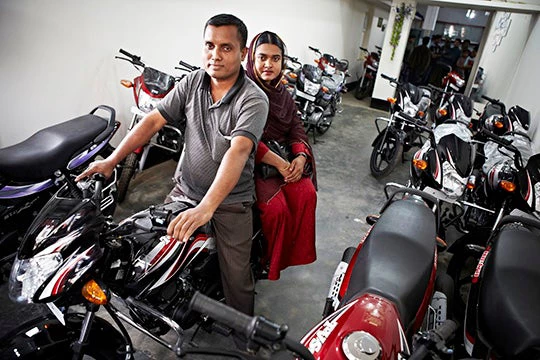
In introductory macroeconomic class, students learn the theory of the multiplier and many interesting counterintuitive notions such as the paradox of thrift and the balanced budget multiplier based on the multiplier process. Essentially, the multiplier multiplies because one person’s expenditure is another person’s income of which they spend a fraction, which in turn becomes another person’s income, of which a fraction is spent and the process eventually converges with subsequent increments to income getting smaller and smaller.
How does the multiplier process work in reality? The Refugee Migration Movement Research Unit (RMMRU) in Bangladesh has recently completed the first phase of a longitudinal research on the impact of external and internal migration on income and poverty in Bangladesh. The research is based on a survey of 5084 external, internal and non-migrant households from 102 villages. Among others, one of the most interesting is their findings on the impact of external migration on local level development through remittances and expenditure behavior of remittance recipients. Note that since the mid-1970s, Bangladesh has participated mostly in the short-term international labor markets of the Gulf and other Arab countries, as well as South East Asian countries. Over the last ten years, an average 500,000 workers have migrated abroad for work each year. Currently, an estimated 8 million Bangladeshi workers are on short-term migration abroad.
In 2013 the short-term international migrant (STIM) households on average received Tk 251,400 (over $3100) as remittance. The maximum amount received was Tk 4,400,000 and the minimum was Tk 6000. The study found international migration plays a significant role in reducing poverty. Only 13 percent of the STIM households were below the poverty line, compared with 40 percent of the non-migrant households. The survey particularly covered those groups that were either below poverty line, experienced occasional deficits, or ‘break-even’ situations at the time of their first international migration.
STIM enjoyed a better living standard compared to non-migrants—18 percent of the STIM compared with 4.6 percent of the non-migrant owned pucca houses; 74 percent of the STIM compared with 58.6 percent of the non-migrants have electricity as their main source of power; and 47 percent of STIMs compared with 18.3 percent of non-migrants have sanitary toilets with water seal. While there is not much difference between migrant and non-migrant household in schooling their children, international migrants spent 37 percent more on private tutoring compared to non-migrants.
STIMs spent 71 percent more in health services compared to non-migrants. Compared to non-migrants, STIMs contributed more to the development of local markets through their larger spending capacity. STIM households annually spent 24 percent more on food and other expenditures compared with non-migrants.STIM households fared much better both in terms of savings and investment, with 34.07 percent having savings accounts, compared with 19.11 percent non-migrant households.
Related to these greater levels of consumption, 35 percent of STIMs constructed new homesteads, compared with 26.4 percent non-migrants. In homestead construction STIM households spent 75 percent more than non-migrants. Almost all STIM households owned homestead land and 43 percent owned agricultural land. They invested most in agricultural production, both as land owners and sharecroppers, using improved seeds, fertilizer, regular irrigation, and insecticides. The investments in agricultural equipment made by STIM were twice that of non-migrants. These included irrigation pumps, power tillers, tractors, paddy-separators, and potable rice processing machines. They also invested in poultry and domestic animals. Around 5 percent of STIM invested in shops and 10 percent invested in transportation.
International migrants created employment for non-migrants of the sending areas through share cropping their land. They also hired workers from non-migrant families to manage poultry farms, livestock, and small-scale enterprises. Nearly four fifths of the high international migrant sending-villages regularly experienced inter-district seasonal migration; 41.7 percent of medium intensity villages experienced such migration and only 33 percent of low intensity migration villages experienced inter-district seasonal migration. During sowing and harvesting season, 47 percent of STIM households employed seasonal migrants. Not surprisingly, high and medium STIM areas had higher wage rates relative to non-STIM areas.
Rural market places have undergone major changes in migrant intensive areas. Along with traditional items each market place has at least one computer composing facility, photocopy, and mobile stores, and other electrical items. Also available were a set of stores which sold construction materials. They had decorators’ stores, which cater to wedding and other occasions. Except fridges, televisions, and computers, almost everything could be purchased in the local marketplace.
The upshot from above is nothing really new. Remittances from international migration contribute to raising the standard of living of not only the recipients but also the non-migrant households living in migration intensive localities through expanding local demand which in turn create employment and increase wages. The simple Keynesian multiplier only focusses on the income-expenditure multiplier process. The findings of this study demonstrate such a multiplier is only part of the story—a very important part for sure. But the full remittance multiplier also encompasses employment and wage effects.
This does not mean international migration has no downsides—inflation, exchange rate appreciation, asset price bubbles, reduced work effort (on the part of recipients), and family disruptions at least in theory. On balance, however, migration from a hugely labor surplus (considering the size of the annual addition to and the extent of under-employment of the existing labor force) economy such as Bangladesh can be presumed to be beneficial to only to the migrants and their families but also the economy as a whole.


Join the Conversation